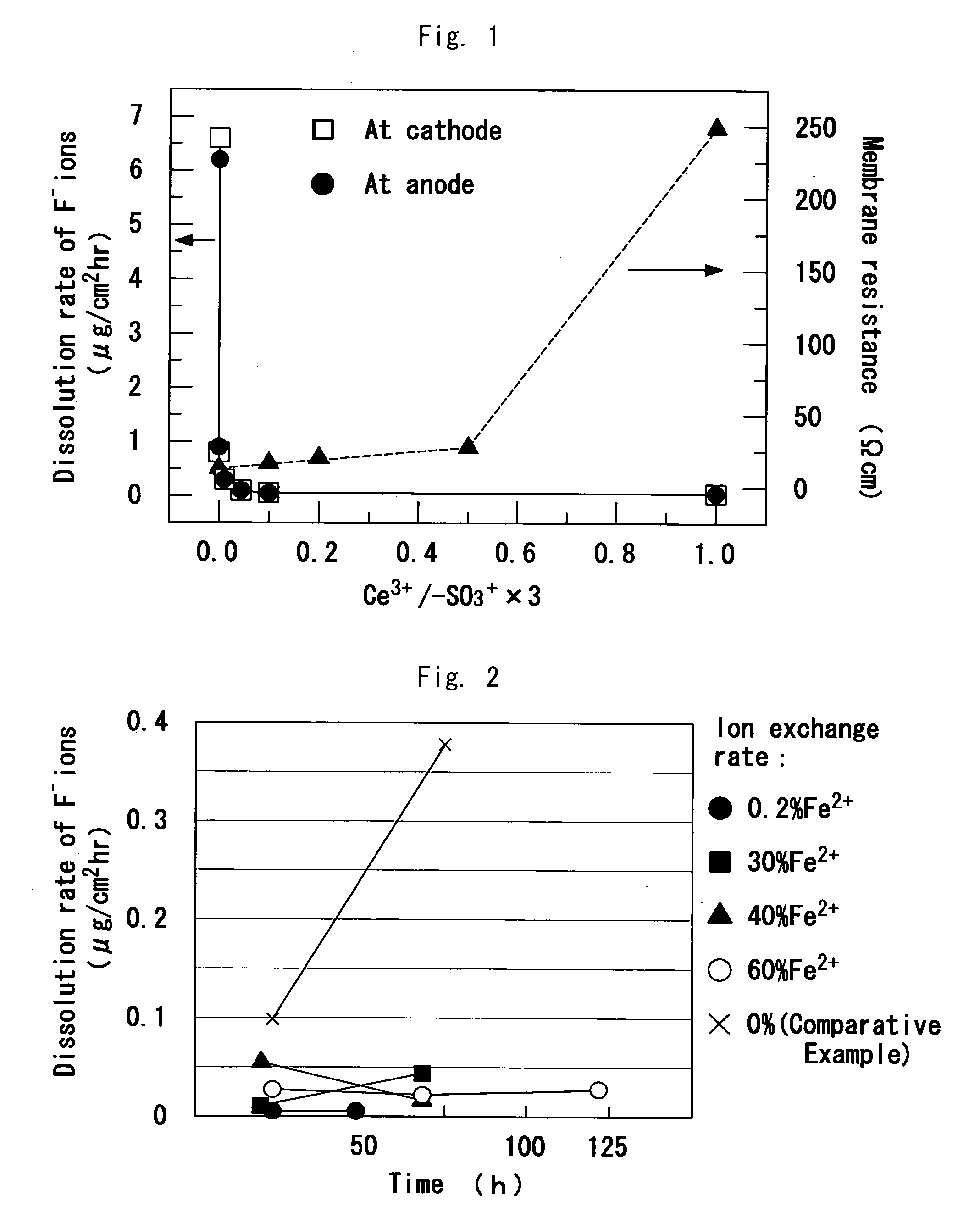Solid polymer electrolyte, solid polymer fuel cell and method for manufacturing the fuel cell
- Summary
- Abstract
- Description
- Claims
- Application Information
AI Technical Summary
Benefits of technology
Problems solved by technology
Method used
Image
Examples
examples 1 to 5
[0065] An appropriate amount of cerium nitrate (Ce(NO3)3. 6H2O) was dissolved in 100 ml of water, and then perfluorinated electrolyte membrane (Nafion (a registered trademark) 112) having a thickness of 45 μm and a size of 7 cm×7 cm was placed in the solution. The solution was heated to 90° C. for 1 hour. Thereafter, the resulting electrolyte membrane was cleaned twice with 100 ml of hot pure water at 90° C. for 30 minutes. Further, the resulting electrolyte membrane was cleaned several times with ion exchange water, and dried under vacuum at 80° C. for 2 hours. Thereafter, the weight E1 was measured. The ion exchange rate with Ce3+ in the treated membranes was measured by titration (0.005 N NaOH) for cation exchange capacity.
[0066] Subsequently, 200 ml of an aqueous solution containing a hydrogen peroxide (1 wt %) and Fe (10 ppm), which was added in the form of ferrous chloride (FeCl2), was prepared. The aqueous solution and the treated membrane were added to a container of a poly...
examples 6 to 18
[0069] The procedure of Examples 1 to 5 was repeated to produce membrane in which 10% of protons of the cation exchange groups were ion-exchanged with various metal ions. The amount of F− ions dissolved was measured in the membrane under the same conditions as those employed in Examples 1 to 5.
[0070] The chemicals used for the ion exchange and the amounts of F− ions dissolved are shown in Table 2. The membranes ion-exchanged with the metal ions shown in Table 2 inhibited discharge of fluorine ions, compared to the membrane (Comparative Example 2) replaced by La3+ at an ion exchange rate of 10%.
TABLE 2IonReagentF (ppm)Example 6CrCr(NO3)3.9H2O3.9Example 7TbTb(NO3)3.6H2O4.5Example 8GdGd(NO3)3.6H2O4.6Example 9SmSm(NO3)3.6H2O4.8Example 10DyDy(NO3)3.6H2O2.8Example 11HoHo(NO3)3.5H2O3.1Example 12ErEr(NO3)3.6H2O3.5Example 13AgAgNO34.3Example 14CoCo(NO3)3.6H2O4.9Example 15HfHfCl45.0Example 16RuRuCl3.nH2O2.0Example 17PdAqueous PdCl2 solution3.0Example 18PtAqueous [Pt(NH3)4]Cl2.H2O solution3...
example 19
[0071] The dry weight of a membrane (EW: 1100, 6 cm×6 cm, Nafion (a registered trademark for products manufactured by DuPont) 112) was measured, and the total number of moles of sulfonic acid groups in the membrane was calculated. Assuming that one Ce3+ ion exchanges with three sulfonic acid groups, the number of moles of Ce3+ ions corresponding to 10% of the total number of sulfonic acid groups was calculated.
[0072] The membrane was dipped in an aqueous cerium nitrate solution containing Ce3+ ions corresponding to the calculated number of moles, and allowed to stand at room temperature for 24 hours. After completion of the ion exchange, the membrane was washed with hot water at 60° C.
[0073] Catalyst layers were transferred to both surfaces of the resulting membrane using a hot press to obtain an MEA.
PUM
| Property | Measurement | Unit |
|---|---|---|
| Fraction | aaaaa | aaaaa |
| Electrical resistivity | aaaaa | aaaaa |
| Fraction | aaaaa | aaaaa |
Abstract
Description
Claims
Application Information
 Login to View More
Login to View More - Generate Ideas
- Intellectual Property
- Life Sciences
- Materials
- Tech Scout
- Unparalleled Data Quality
- Higher Quality Content
- 60% Fewer Hallucinations
Browse by: Latest US Patents, China's latest patents, Technical Efficacy Thesaurus, Application Domain, Technology Topic, Popular Technical Reports.
© 2025 PatSnap. All rights reserved.Legal|Privacy policy|Modern Slavery Act Transparency Statement|Sitemap|About US| Contact US: help@patsnap.com

